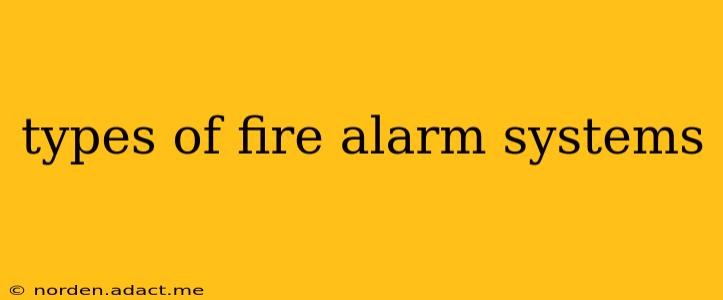Fire safety is paramount, and a reliable fire alarm system is the first line of defense. Understanding the different types of fire alarm systems available is crucial for homeowners and businesses alike to ensure the right protection is in place. This guide will explore the various systems, their functionalities, and their suitability for different environments.
What are the different types of fire alarm systems?
There are several types of fire alarm systems, each with unique characteristics and capabilities. The most common classifications are based on the detection method and the notification method. Let's break down the key types:
1. Conventional Fire Alarm Systems
These systems are the most basic and affordable option. They use a single circuit to connect all the detectors and notification appliances (like bells or horns). When a detector senses a fire, it triggers the entire system, indicating a fire somewhere within the protected area. While simple, this lack of specific location information can lead to confusion and delayed response during an actual fire event.
Advantages: Cost-effective, simple to install and maintain.
Disadvantages: Limited pinpoint accuracy, potential for false alarms to shut down the entire system.
2. Addressable Fire Alarm Systems
These systems offer a significant upgrade in functionality. Each detector and notification appliance has a unique address, allowing the control panel to pinpoint the exact location of a fire event. This precision is invaluable for faster response times and more efficient evacuation procedures. Addressable systems also provide detailed diagnostic information, facilitating proactive maintenance and minimizing downtime.
Advantages: Precise location identification, detailed diagnostic capabilities, reduced false alarm rates, improved response times.
Disadvantages: More complex installation and maintenance, higher initial cost.
3. Analog Addressable Fire Alarm Systems
Analog addressable systems build on the capabilities of addressable systems by providing continuous monitoring of each device's status. This means the system can detect subtle changes in the environment, potentially indicating a developing fire before it becomes a full-blown emergency. They also often incorporate intelligent features, such as early warning capabilities and the ability to compensate for environmental factors.
Advantages: Continuous monitoring, intelligent features, early warning capabilities, improved sensitivity.
Disadvantages: More complex and expensive than other systems.
4. Wireless Fire Alarm Systems
These systems utilize radio frequencies to communicate between detectors, notification appliances, and the control panel. This eliminates the need for extensive wiring, making them ideal for retrofitting existing buildings or locations where running wires is difficult or impractical. However, reliability is crucial and potential interference must be considered.
Advantages: Easy installation, suitable for retrofitting, less disruptive installation.
Disadvantages: Potential for interference, reliance on battery power, possible security vulnerabilities.
What are the different types of fire detectors used in fire alarm systems?
Different types of detectors are used to detect various types of fires. Common types include:
-
Smoke Detectors: These are designed to detect the presence of smoke, which is a common byproduct of many fires. They are further categorized into ionization and photoelectric detectors, each with its strengths and weaknesses in detecting different types of smoke.
-
Heat Detectors: These detectors activate when they sense a significant rise in temperature. They are often used in areas where smoke detectors may be prone to false alarms, such as kitchens or industrial settings.
-
Flame Detectors: These detectors use infrared or ultraviolet sensors to detect the visible or invisible radiation emitted by flames. They are often used in high-risk areas or where early detection of fast-spreading fires is crucial.
What is the difference between a fire alarm and a fire sprinkler system?
A fire alarm system is a detection and notification system that alerts occupants of a fire. It uses detectors to sense the fire and then activates alarms (horns, bells, strobes) to warn people and initiate evacuation. A fire sprinkler system, on the other hand, is a suppression system that actively extinguishes or controls a fire by releasing water or other suppressants. Ideally, both systems are used together for comprehensive fire protection.
Which type of fire alarm system is best for my home or business?
The best type of fire alarm system depends on several factors, including the size and type of building, the level of risk, budget considerations, and local building codes. Consult with a qualified fire safety professional to assess your specific needs and determine the most appropriate system. They can help you navigate the complexities of various system types and ensure you choose the best protection for your property and those who occupy it.
